New 2-Bay NAS for a New Decade – Does the TS-251D Deserve Your Data?
If you have found this NAS review, then chances are that you already know a little about the QNAP TS-251D. In fact, I will go a little further. There is a good chance that you (yes, you reading this) are one of the people that were looking to buy a new NAS solution at the end of 2019 and found that…well… nothing was released. Yes, there was a tonne of high-end enterprise rackmounts, along with a bundle of new software improvements – but for the home or small business owner, the NAS scene was pretty quiet. There was plenty of reasons for this, ranging from a constantly evolving world economy, the hardware shortages, to changes in cloud trends and a little bit of uncertainty to boot. Whatever the reason, the usually busy September-December period of 2019 was oddly quiet. However, the more I hear, the more I am convinced that 2020 is looking ridiculously busy! The new TS-251D is a step into a new decade for QNAP NAS and with it, we see a much more mature, established and self-assured company than ever before. With a newer generation of pretty much, every hardware component in the TS-251D over its predecessor (the TS-251B), there is alot to love, but is this new QNAP NAS just a rehash of the old or are we looking at a 2-Bay that is exactly what we needed! Let’s find out.
QNAP TS-251D NAS Review – Quick Conclusion
We have seen many new releases announced in 2019 from QNAP and now they are arriving in 2020, there did seem to be ALOT of business and not enough pleasure! The TS-251D fixes this by giving you a great middle-ground for home and/or business users, finding an affordable hardware package that is genuinely tough to beat. The TS-251D NAS features everything you want in the latest generation of NAS, especially from an innovative brand like QNAP, but does it without commuting you to hardware that you may never use or feel doesn’t have a place in your budget.
QNAP TS-251D NAS Review – Retail Kit
Unsurprisingly, the retail box of the QNAP TS-251D is very much what you would expect. Featuring plenty of details about the QNAP brand, the software specs, the hardware inside and more, in this newer release you can see alot of nods to changing NAS culture, with mentions of Plex Media Server, Virtual Machines and Home compatibility. The retail box seems a little big for a 2-Bay, but this is largely because of the internal retail box structure and not the TS-251D itself.
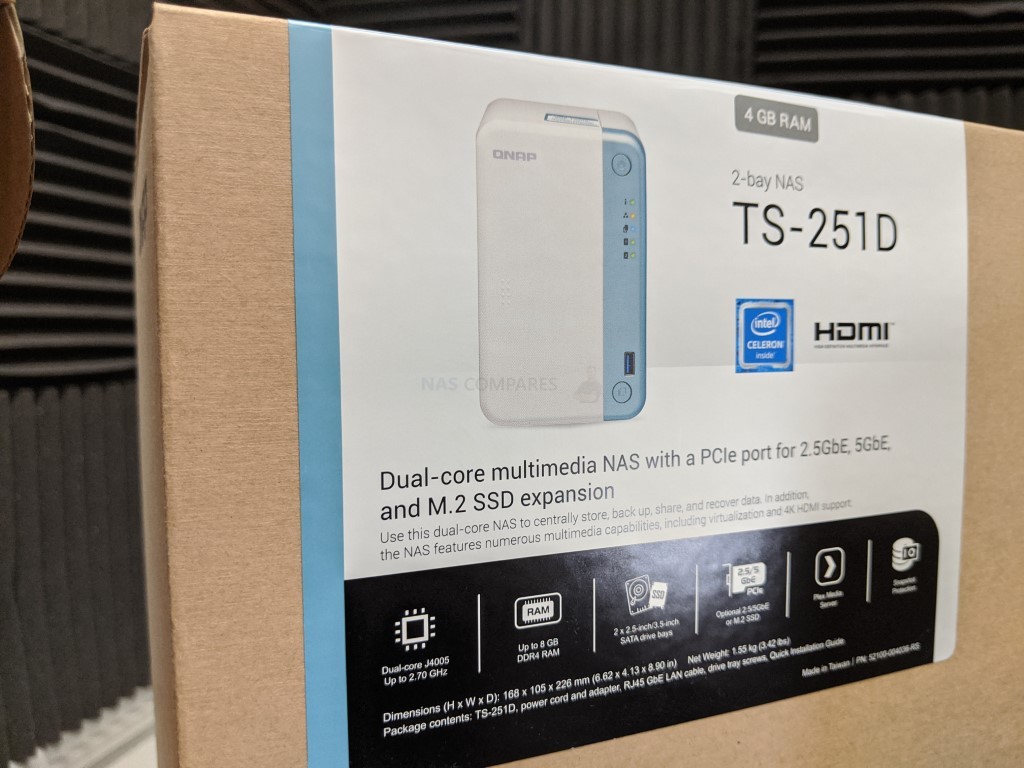
Opening up this retail box shows us the TS-251D itself (in wrapping) and an accessories box. This is fairly standard for NAS drives, though QNAP is still the brand that includes the most accessories per NAS compared with other brands and aside from an HDMI cable, can’t see you needing anything else for the initial setup – aside from HDDs obviously.
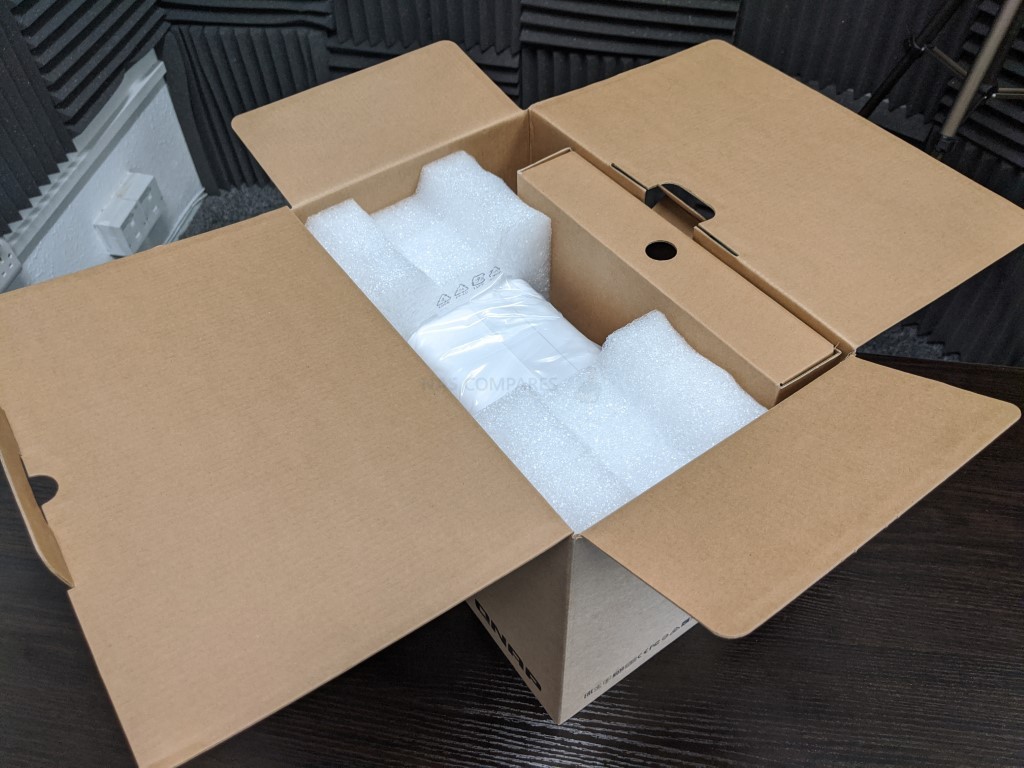
Removal of all the packaging shows us the TS-251D NAS itself, leaves us with a much small collection of hardware to look through
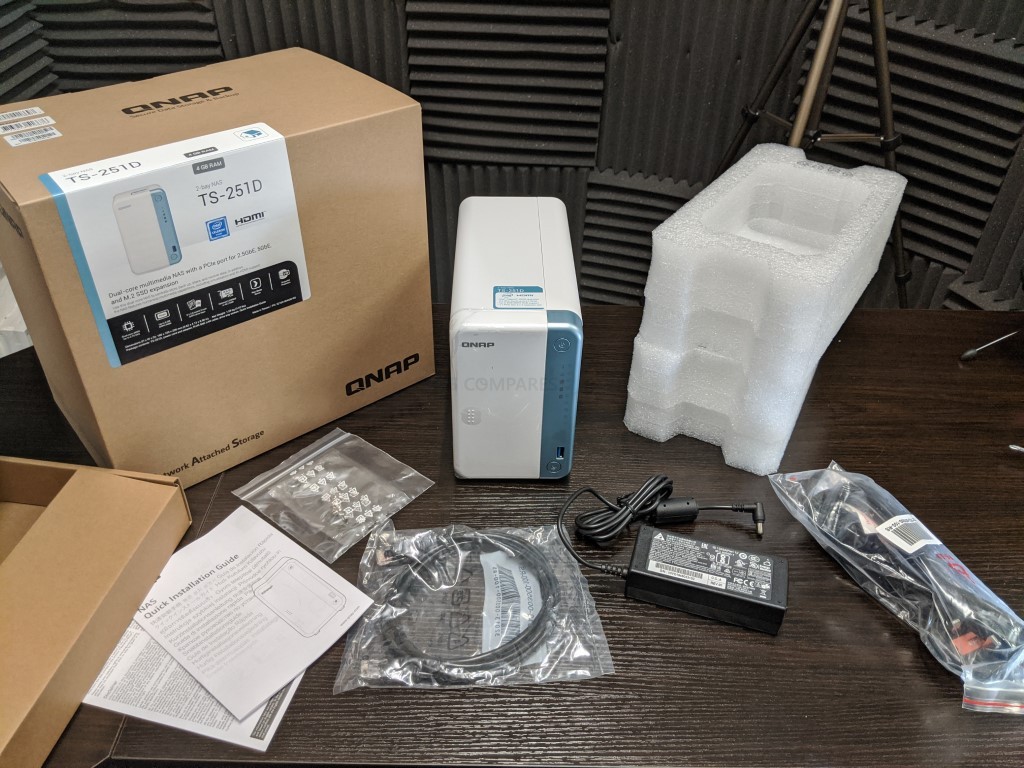
Fairly standard stuff and the PSU is especially small for such a comparatively powerful NAS
- 1x Ethernet Cable
- Quick Installation Guide
- Warranty Information
- Main Power Connector
- HDD/SSD Screws
- 65W PSU
The only complaint I have in terms of the TS-251D retail kit and accessories is the same one I ALWAYS have – the lack of HDMI cable! I know this is a remarkably minor point, but given the 4K 60FPS HDMI 2.0a port is a primary selling point, as well as fewer and fewer devices, are released these days with the cable included – including a cable ould cost practically nothing extra AND would help users try out the HD Station applications straight out of the box.
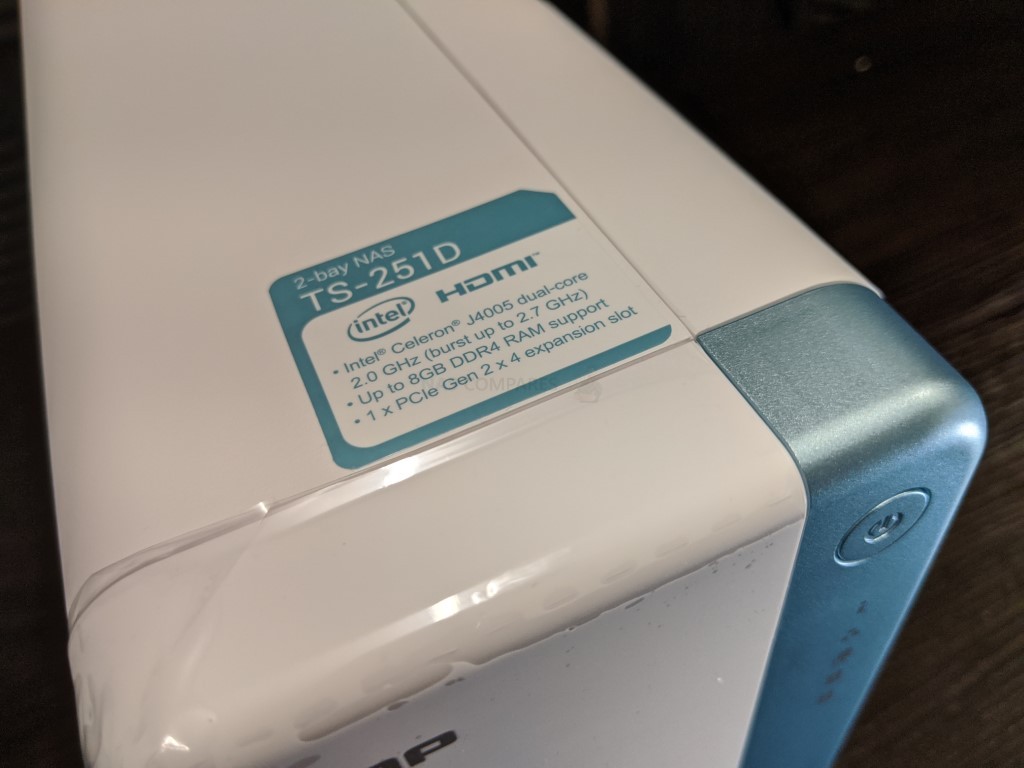
QNAP TS-251D NAS Review – Design
The chassis consists of a combination of the plastic external casing and metal internals. The chassis is identical to that of the TS-251B (favouring metallic blue over the silver in the predecessor) and that’s not a bad thing. QNAP has been featuring this chassis in their 2-Bay Home/SMB NAS range for a few years now and each tier of their range adds a little something different to the mix.
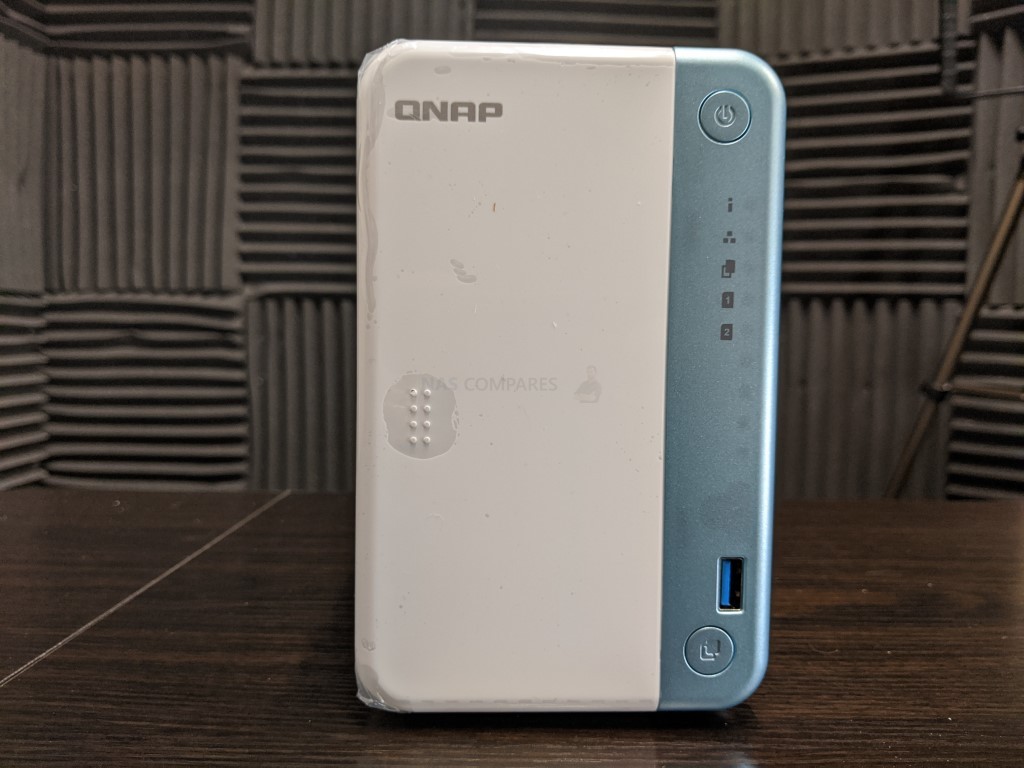
Measuring 16.8cm × 10.5cm × 22.6cm without the external power brick, the TS-251D is a pretty compact device. Although the size and general design is remarkably similar to that of the TS-251B, TS-253Be and TS-253B, you can easily spot the differences between them and the newest addition is probably the most nondescript.
| QNAP TS-251D – 2020 | QNAP TS-251B and TS-253B – 2018/19 |
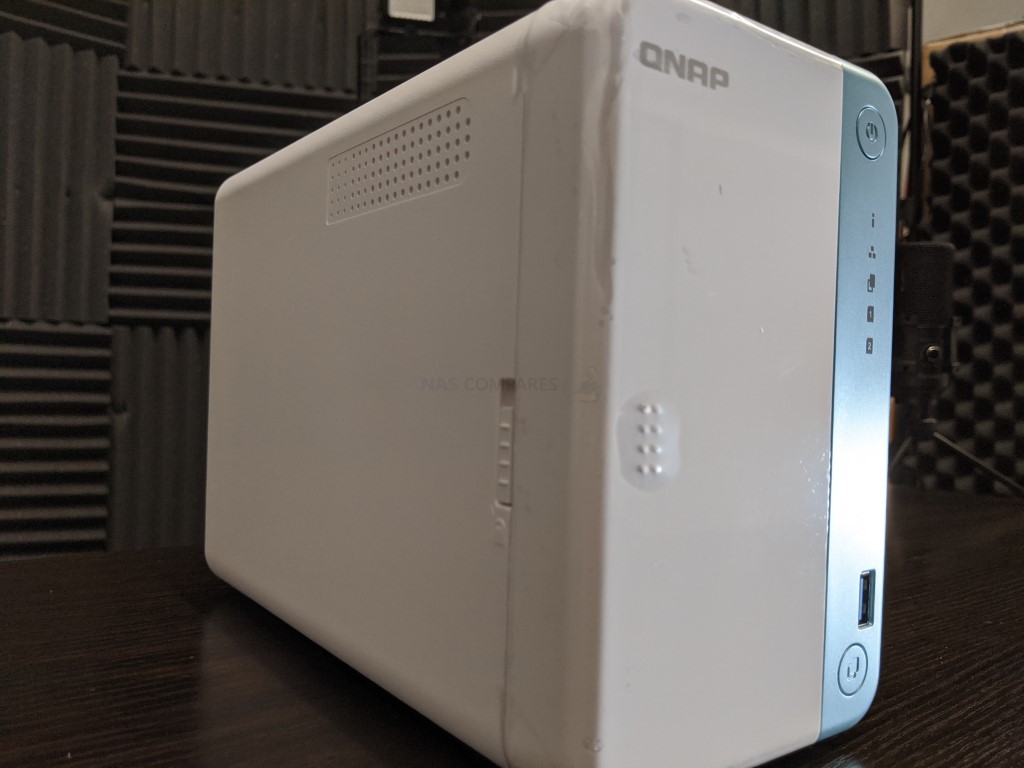 |
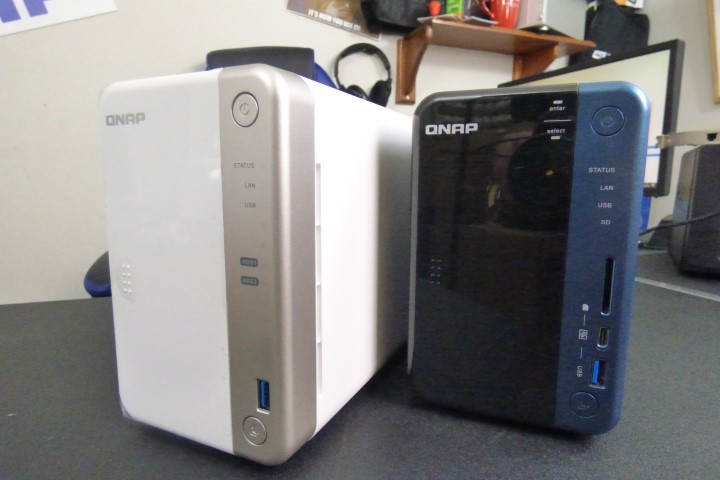 |
The front of the case does lack several of the hardware of the older TS-253B, such as an SD Card slot, USB Direct Access port and LCD panel, but given that the TS-251D is around £200 cheaper, this is pretty fair.
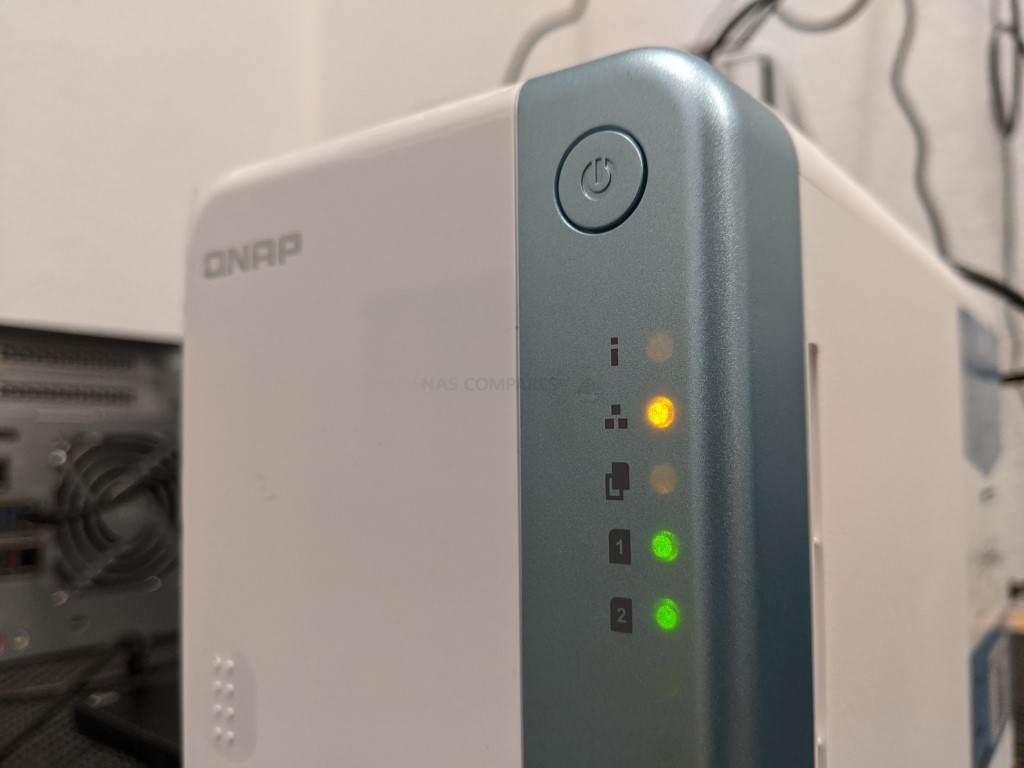
When the unit is in operation, the TS-251D features LEDs (much like any other NAS) that can be dimmed/brightened as needed in the QTS software. Each LED (in 3 colours) provides indications on Power/Status, LAN connectivity and activity, USB Copying, and individual lights for each HDD/SSD installed. Unlike a number of other QNAP’s there is no LCD panel, but the LEDs are pretty much all you need for a casual glance at the activity.
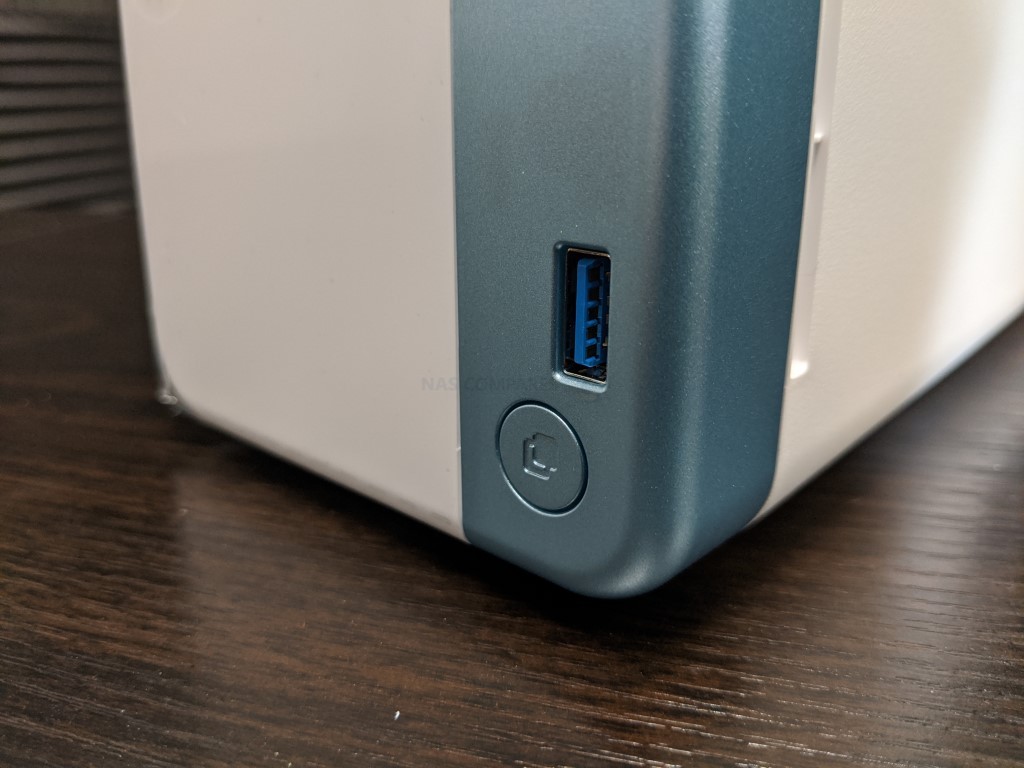
One feature that I am pleased to confirm is on the TS-251D is a front-mounted USB port and a one-touch copy button. This is great for ad-hoc backups too/from the NAS, as well as the included Hybrid Backup Sync software that allows you to create multiple tiers of a backup strategy. a one touch backup button is not essential, as often the system can be set up to automatically trigger a backup, but a physical button is always useful.
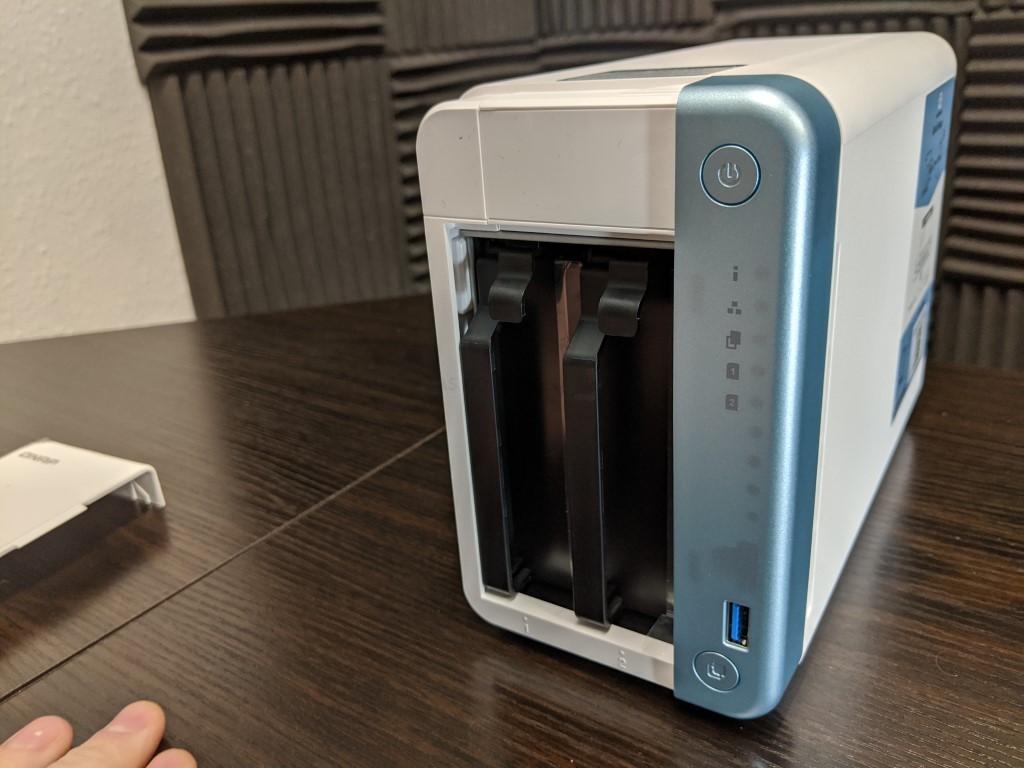
The 3.5″ media trays are located at the front of the TS-251D NAS case. The front panel can be removed easily by sliding the unlock button on the side. The two bays feature no key locking mechanism, but your drives would still be well protected from accidental drive removal. The trays themselves are plastic in design.
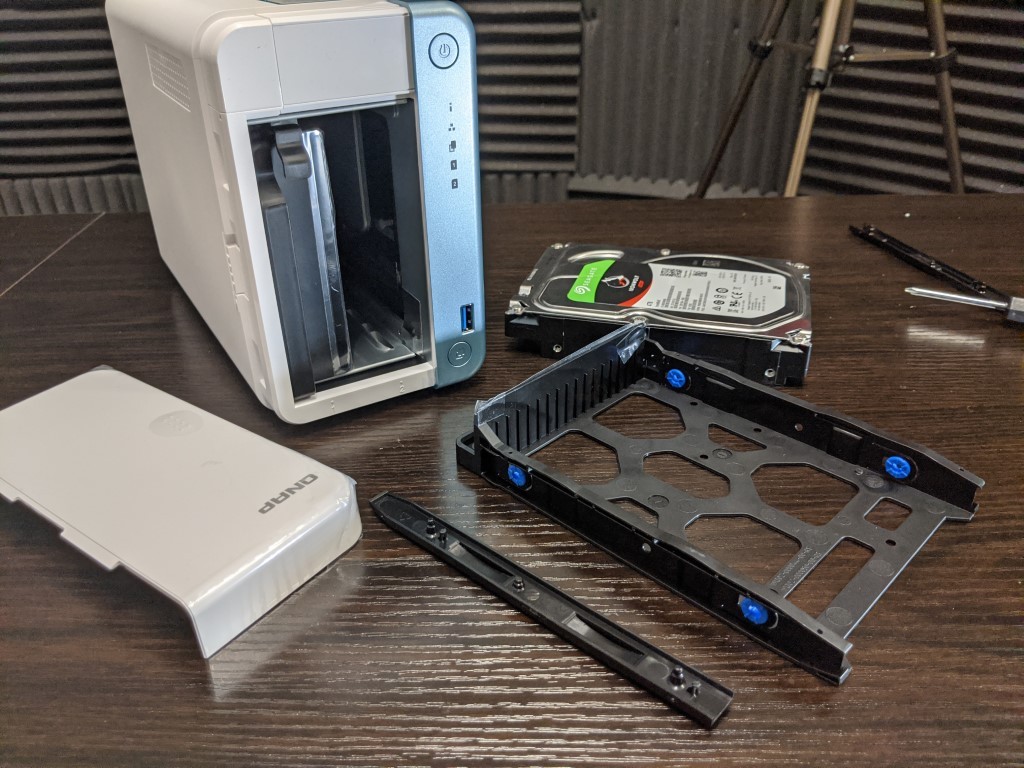
Each tray features a ‘click and stay’ design, so installing a 3.5″ hard drive is remarkably easy. Supporting the latest NAS hard drives (currently 14TB with WD Red and 16TB with Seagate Ironwolf) you can run the TS-251D on a single drive if you wish, or installing two drives in a RAID configuration with the QNAP initial setup. With regards to SSD usage, each tray features screw holes at the base for 2.5″ media.
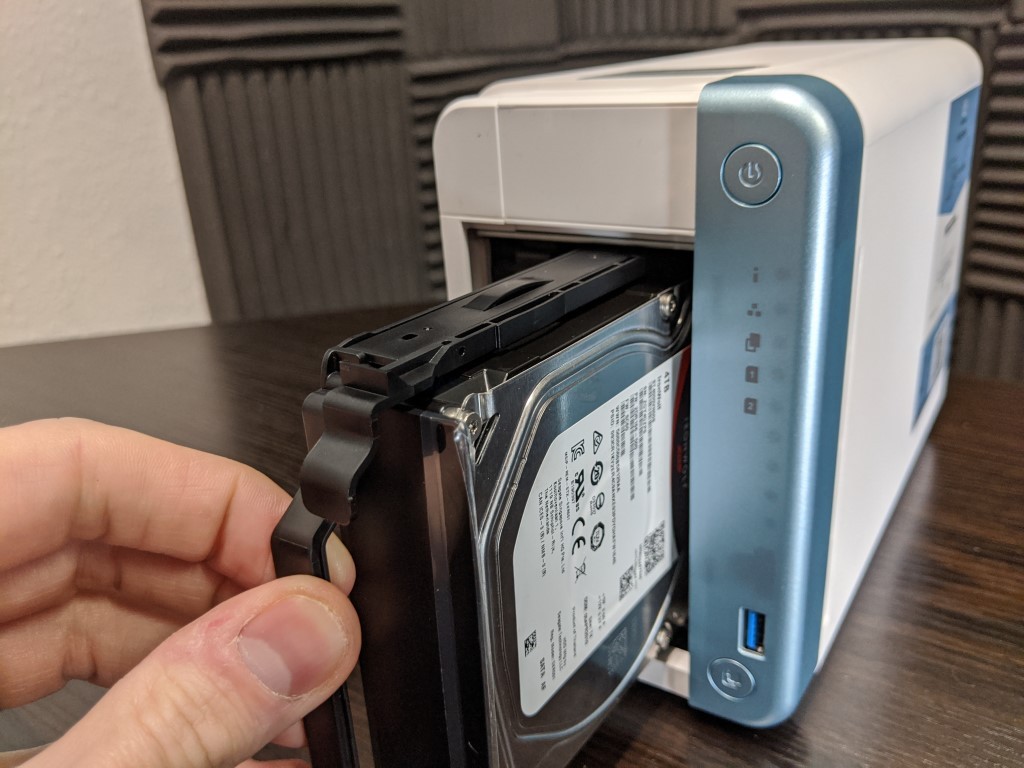
The trays themselves are pretty standard in design. Although they are plastic, they are pretty rigid and if you are looking at utilizing hot-swapping (exchanging drives whilst the device is operational), then the TS-251D tray architecture is pretty nice – plus reduces noise. If you remove the trays completely, you can see the DDR4 memory modules. This makes upgrading your RAM super easy from the default 2/4GB.
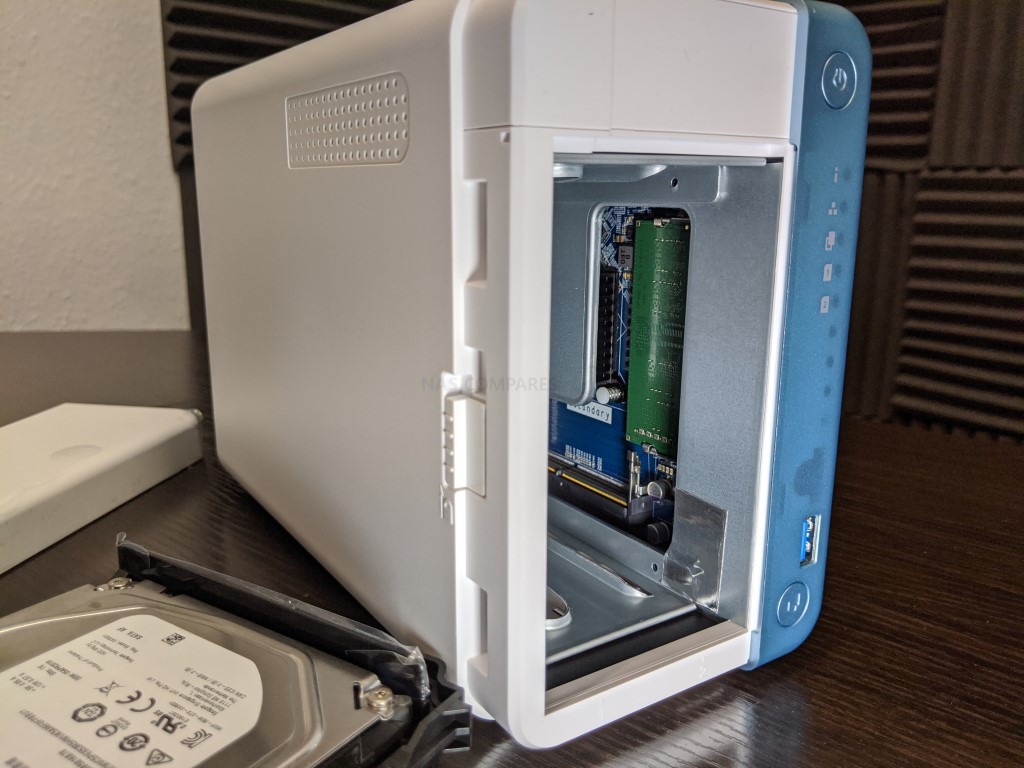
If we take a look at the sides of the TS-251D, we can see two lots of ventilation, working as a passive cooling measure to assist the active cooling FAN. The internals of the device do not feature a CPU fan, but favour heatsinks in key component locations.
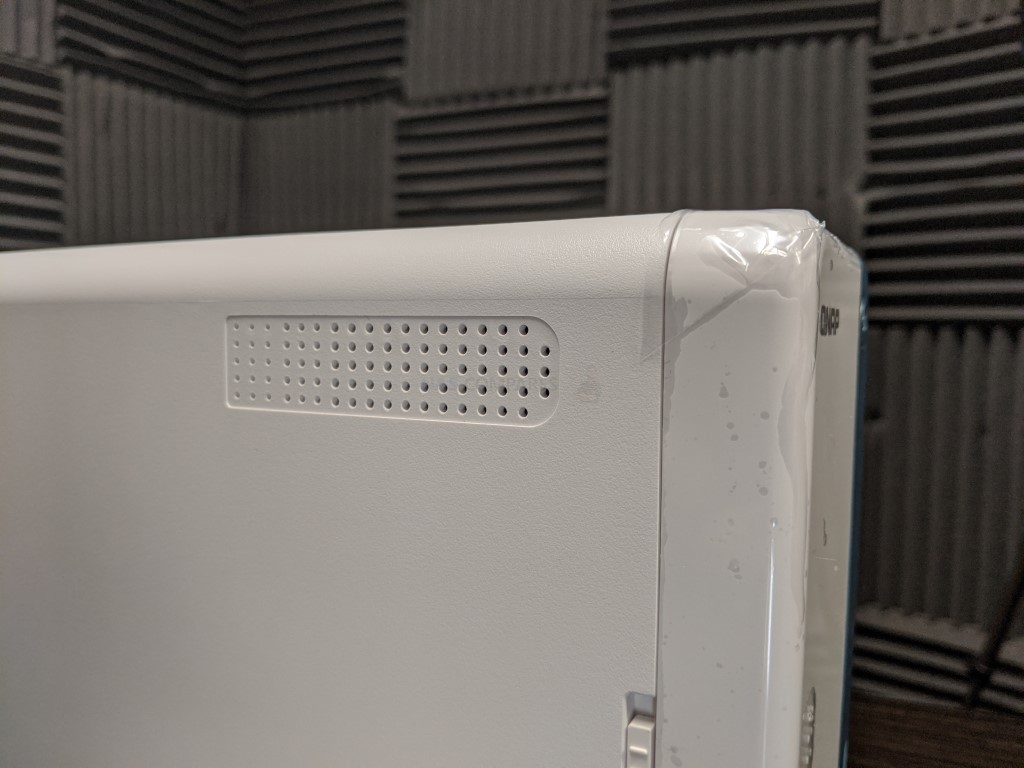
Alongside the ventilation on each side of the chassis, the base of the TS-251D has a short, but wide ventilation panel that helps cool air pass across the HDD/SSD that are installed.
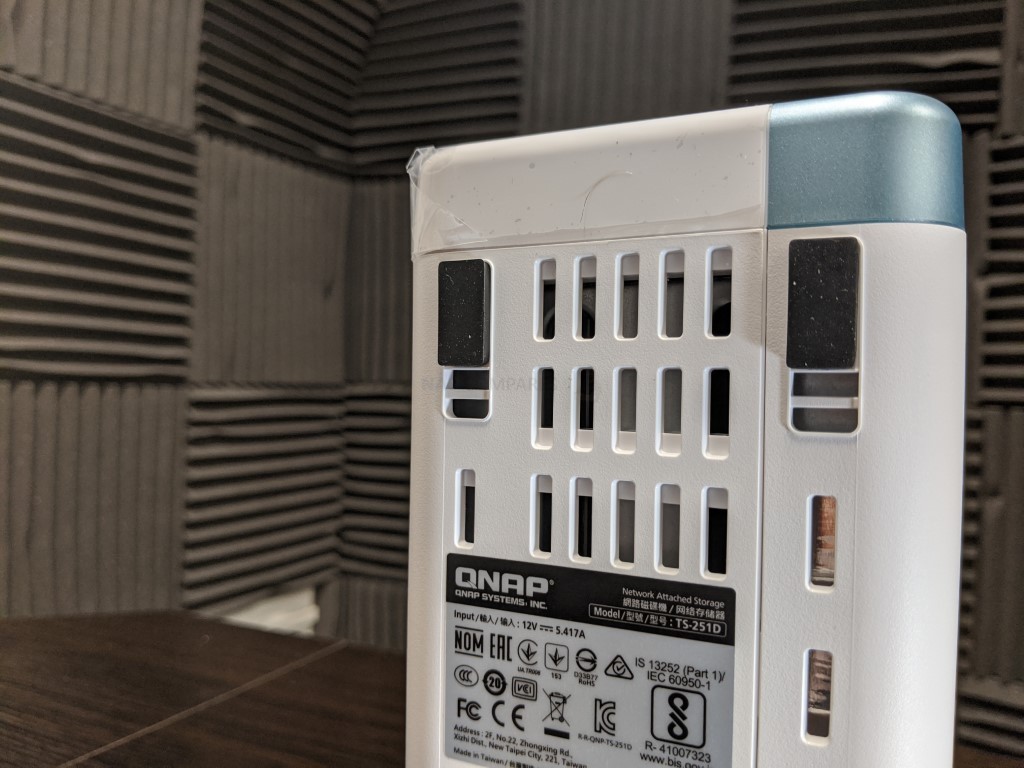
Overall, the TS-251D is a quite petite design and the compact nature of the chassis means that it will have a much smaller impact of your hardware environment overall and noise levels (As long as you avoid more industrial built high-end capacity hard drives) are going to be pretty low!
QNAP TS-251D NAS Review – Ports and Connections
Taking a closer look at the rear of the TS-251D shows us some impressive connections possible at this price point. Also, there are some noticeable absences in the form of audio in/out and a speaker that was found in the TS-251B.
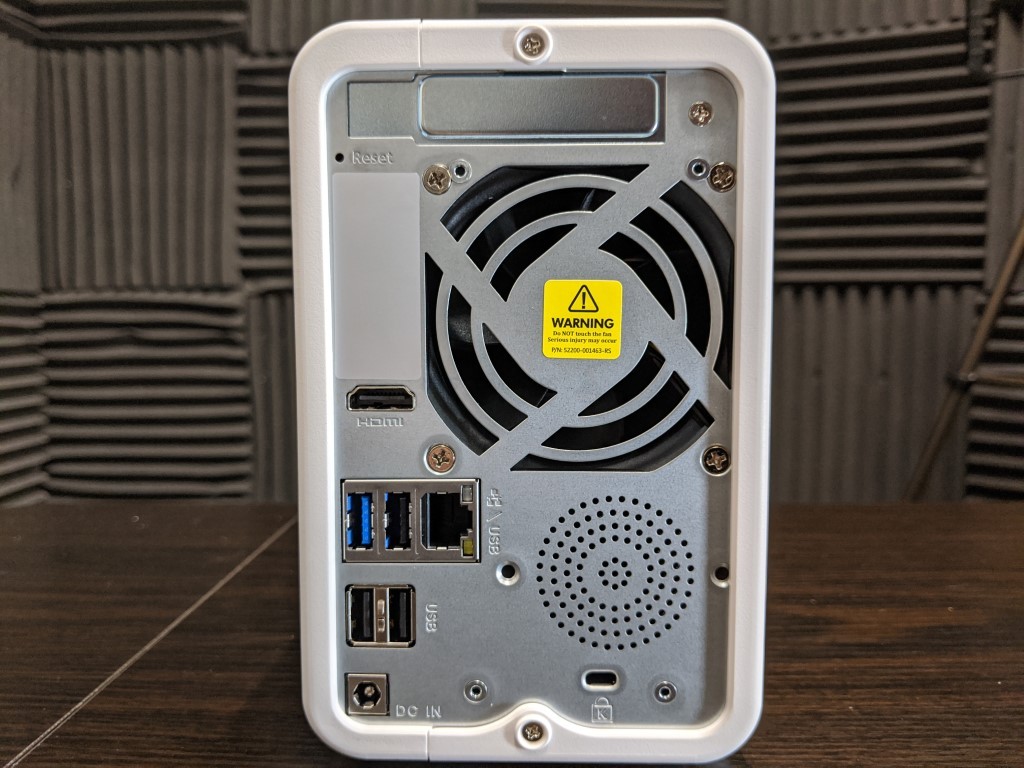
Given the way QNAP have moved in the network hardware market lately, I was surprised to not see 2.5Gbe as the default network port. Then again, this is still relatively new in the industry (less than a year on the NAS scene).
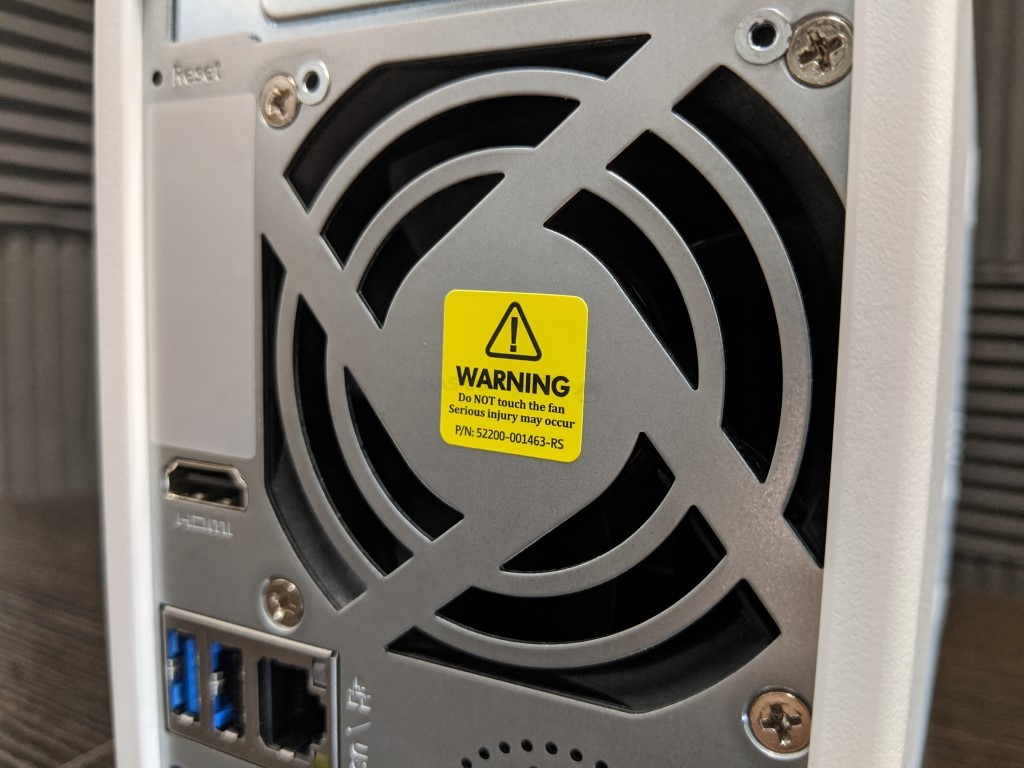
The rear fan measures 70mm and the rotations per minute (RPM) can be adjusted manually or automatically as needed. I would recommend keeping it at automatic, however, as the TS251D is designed to be a 24×7 device.
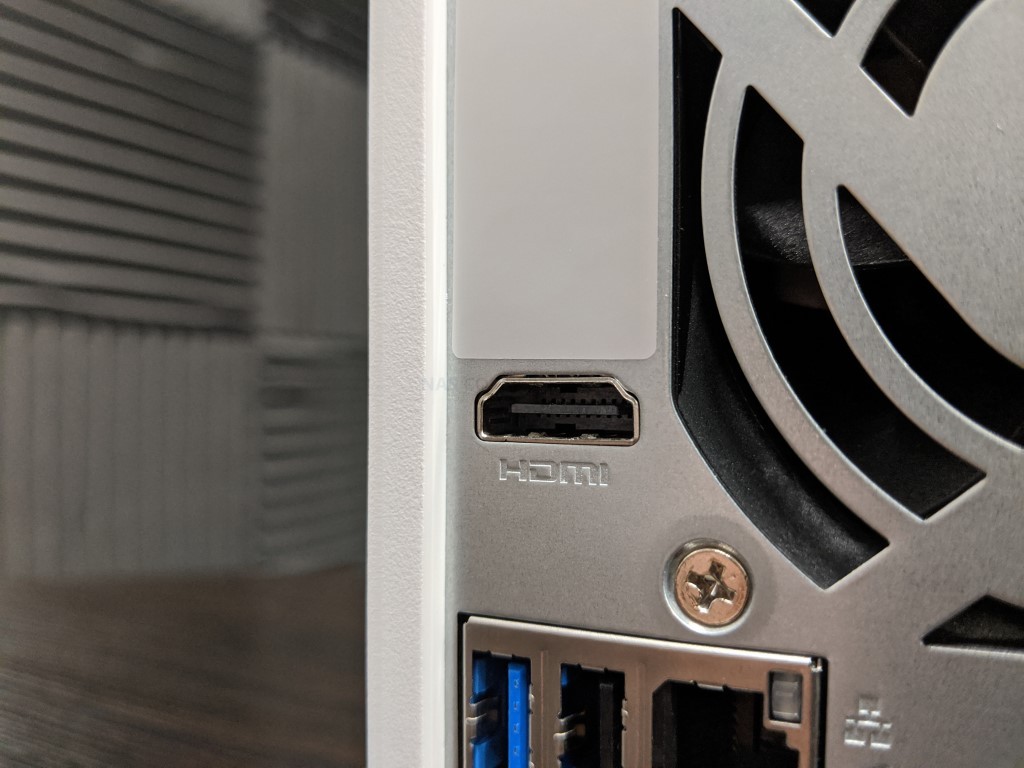
The HDMI out port is HDMI 2.0a – which I think should be the standard in 2020. Arriving with support of 1080p and 4K at 60fps, it means that you can access media directly over the HDMI connection between the TS-251D and your TV/Monitor, resulting in next to zero latency in playback! Additionally, the HDMI Port is equipped with HD Station, the complete graphical user interface and natively controlled platform.
HD Station via the HDMI port can be controlled by an IR remote control, a USB Controller, keyboard+Mouse, or even the completely free QRemote application for iOS and Android. This allows you to run some fantastic operation locally, such as:
- HD and 4K Multimedia Centre
- KVM supported Surveillance System
- Standalone Computer (just connect a keyboard and mouse) that allows Windows, Linux, Container and Android virtual computers
- Emulate Computer Games for play, directly from the NAS (using RetroArch or numerous free games in the app center
- Use as a file system with a direct graphical user interface
- Edit files with LibreOffice, Photo Editing tools and more
ALL of these functions can be run via the HDMI port (connecting a controlling device as mentioned) SIMULTANEOUSLY with the NAS doing its day-to-day job for hundreds of users at the same time.
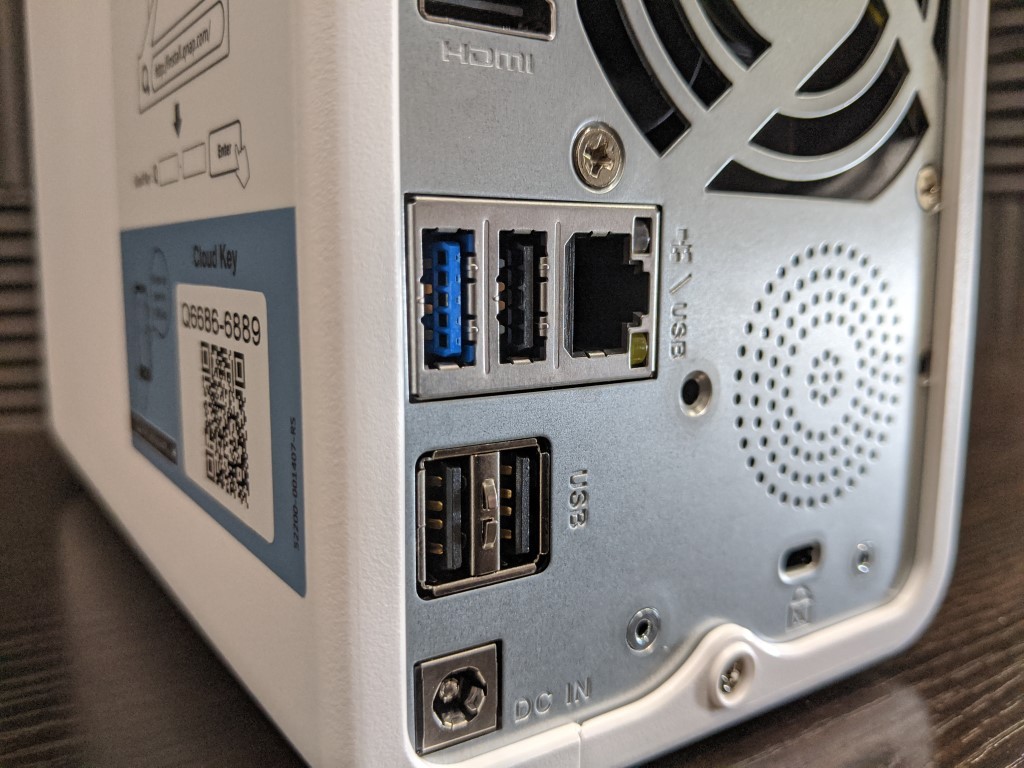
In terms of data connectivity, we have 4 more USB ports (3x USB 2.0 and 2x USB 3.0) for connecting a multitude of supported peripheral devices. These range from USB WiFi Dongles to Bluetooth adapters, Controllers, UPS devices, 5Gbe to USB adapters, Web Cameras and more. The fact we are seeing some USB 2.0 here is a little underwhelming, but I guess that you will almost certainly only use 2-3 USB ports for storage and the rest for regular peripherals that aren’t able to take advantage of the speed/power of a USB 3.0 Port anyway. Next to those USB ports, we find a single RJ45 1Gbe LAN port. This is the means of connecting the TS-251D to your network and (if you choose to) the internet. As mentioned, I am a little surprised that it is not 2.5Gbe by default, given the push that QNAP and other brands have been making on this (as well as the cost point of it now being incredibly close to 1Gbe at the point of manufacture). Additionally, I am surprised it is only a single RJ45 port – no link aggregation. I know this may well be because it would then tread on the toes of the TS-253Be, or increase the base price, but still, it is a shame for such a capable CPU to be fractionally bottlenecked in this way. Alternatively, you can use the QNAP QNA-UC5G1T (see below).
The PCIe Gen 2 x4 slot, however, is very interesting indeed. The TS-251D NAS allows you to upgrade a number of transmission and performance options on day 1, or later in the life of the device if you need to improve things. This slot allows you to add 10Gbe connectivity (along with 2.5Gbe and 5Gbe too), add a powerful wireless connection with the QSW-AC2200 card, use one of the many QM2 Cards from QNAP to add NVMe caching and/or 10Gbe on board and more.
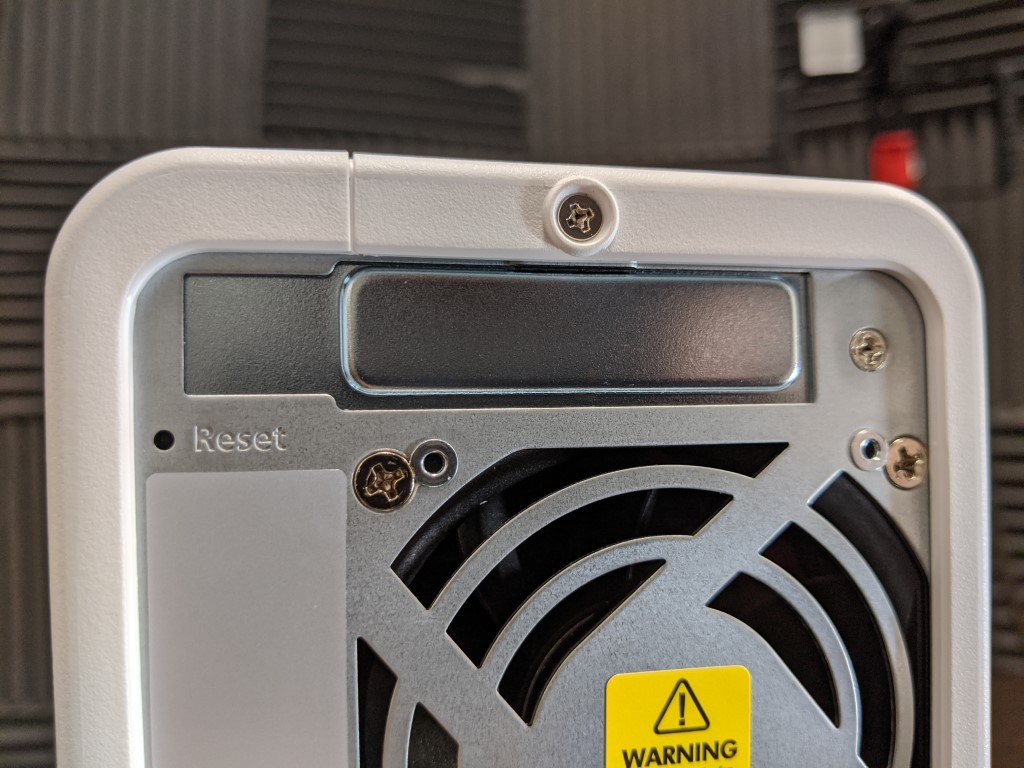
This slot opens the door to faster access, more storage, better caching of data and overall allows you to make the TS-251D incredibly flexible down the line. This video will explain why the PCIe 2×4 (compared with the PCIe 2×2 in the TS-251D) is a good thing:
Despite the multitude of things you can do with that PCIe slot, the majority of users will no doubt use it to open the door to 10Gbe connectivity. This kind of connection allows you to do several things with the TS-251D, such as:
- Connect the TS-251D to a 10Gbe enabled network (switch) and give upto 10 users full 1Gbe connectivity with the NAS each
- Connect DIRECTLY to the TS-251D with a 10Gbe port on both the NAS and the connecting PC/Mac for 10x usual access speeds, allowing photo/video editing on a professional scale
- Connect the 10Gbe port of the NAS to ANOTHER 10Gbe NAS and then create a transfer link for synchronization or backups (little experimental, maybe don’t do this!)
QNAP themselves report access speeds over 10Gbe in a regular windows file transfer to be 982MB/s read and 892MB/s write – though this is not typical of all interactions and I recommend you visit the QNAP performance page for lots more tests in other environments with 1Gbe and 10Gbe.

Speaking of 1Gbe, I can confirm that the CPU and general architecture of the TS-251D results in FULL 1Gbe connectivity over the network. This shouldn’t be a massive surprise, but still nice to know.
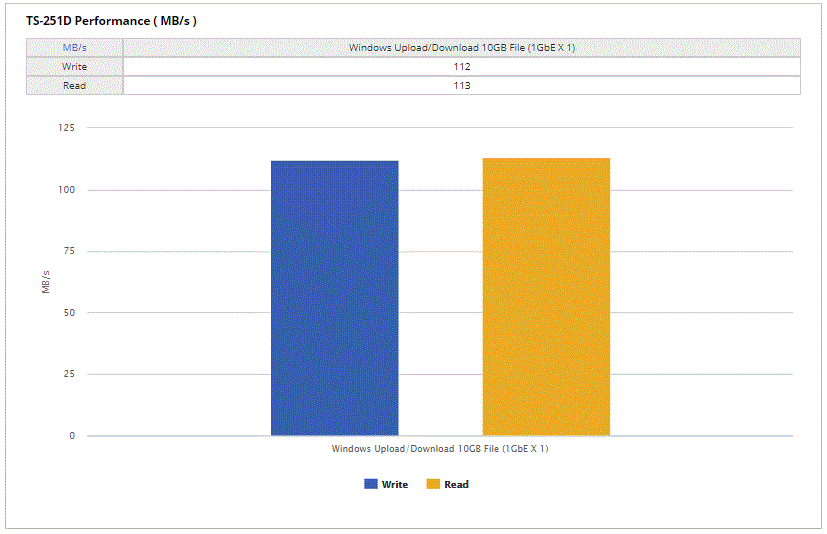
QNAP TS-251D NAS Review – Internal Hardware
We have already discussed the internal hardware a bit in this review, but it is worth digging a little deeper. The main CPU of the TS-251D is the Intel Celeron J4005. This dual-core 2.0 GHz processor (burst up to 2.7 GHz when needed) is a 64-bit x86 architecture chip, so this opens the door to a large variety of applications being used. This is both due to its impressive clock speed and architecture in file handling, but also because of the processor featuring embedded Intel HD Graphics 600. This means that Plex, VMs, Graphical file handling, 4K transcoding and more is available – and the QNAP + 3rd party apps definitely take advantage of the extra horsepower under the hood.
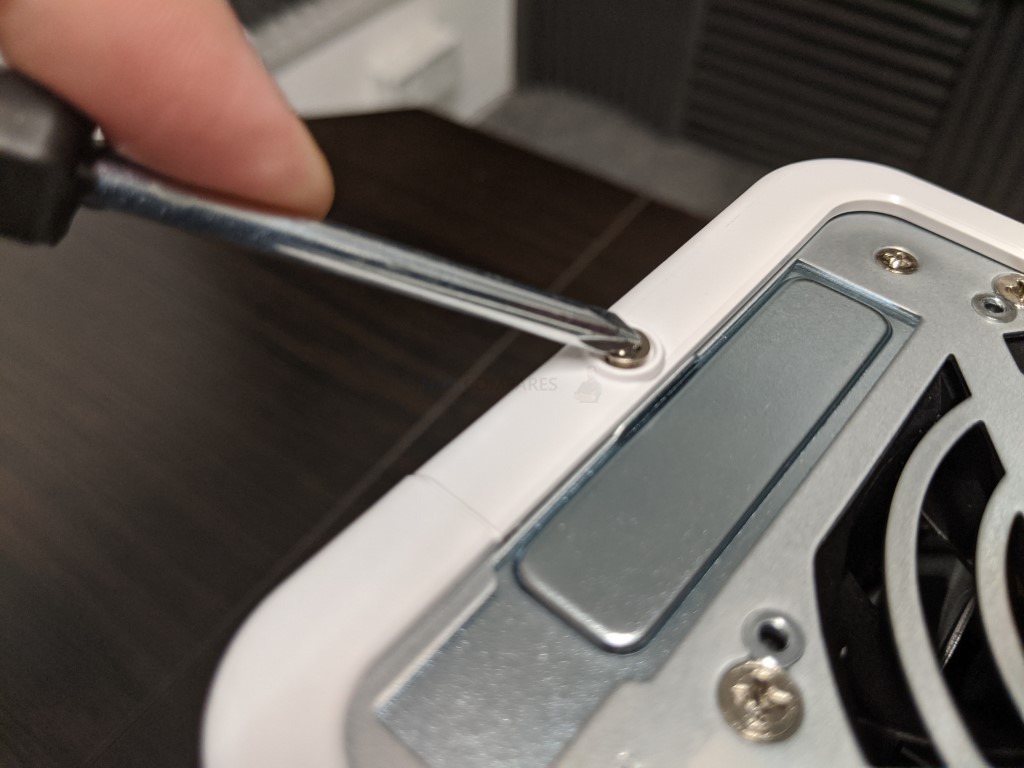
Outside of large scale graphical operations, the J4005 processor is also remarkably good at file handling, with some fantastic read/write internally for a mid-range 2-Bay NAS, both generally and utilizing the 256bit AES-NI encryption enabled on all transmission.
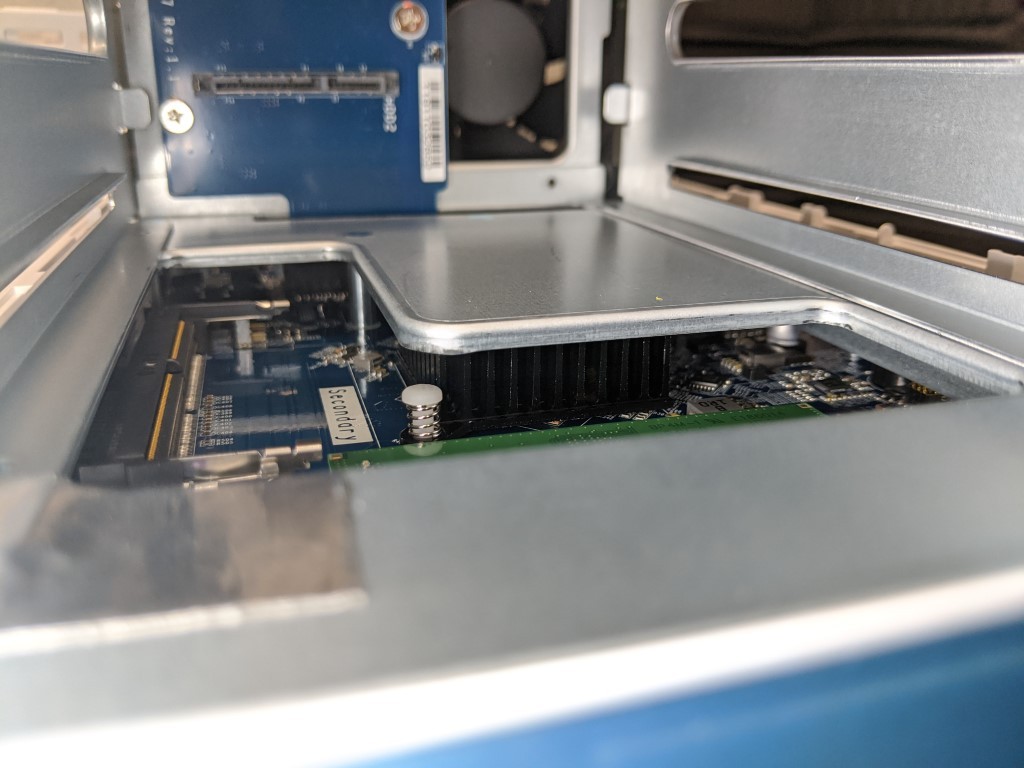
This processor is paired with 2 slots of DDR4 memory, SO-DIMM DDR4 to be precise. This is a higher frequency than the DDR3L featured in the TS-251D and by default, the device arrives with 2 or 4GB, but can officially be expanded to 8GB – as well as unofficially upgraded to 16GB (I suspect – and testing will take place shortly). This is a nice extra upgrade over it’s predecessor and helps justify the small price increase. See Below:
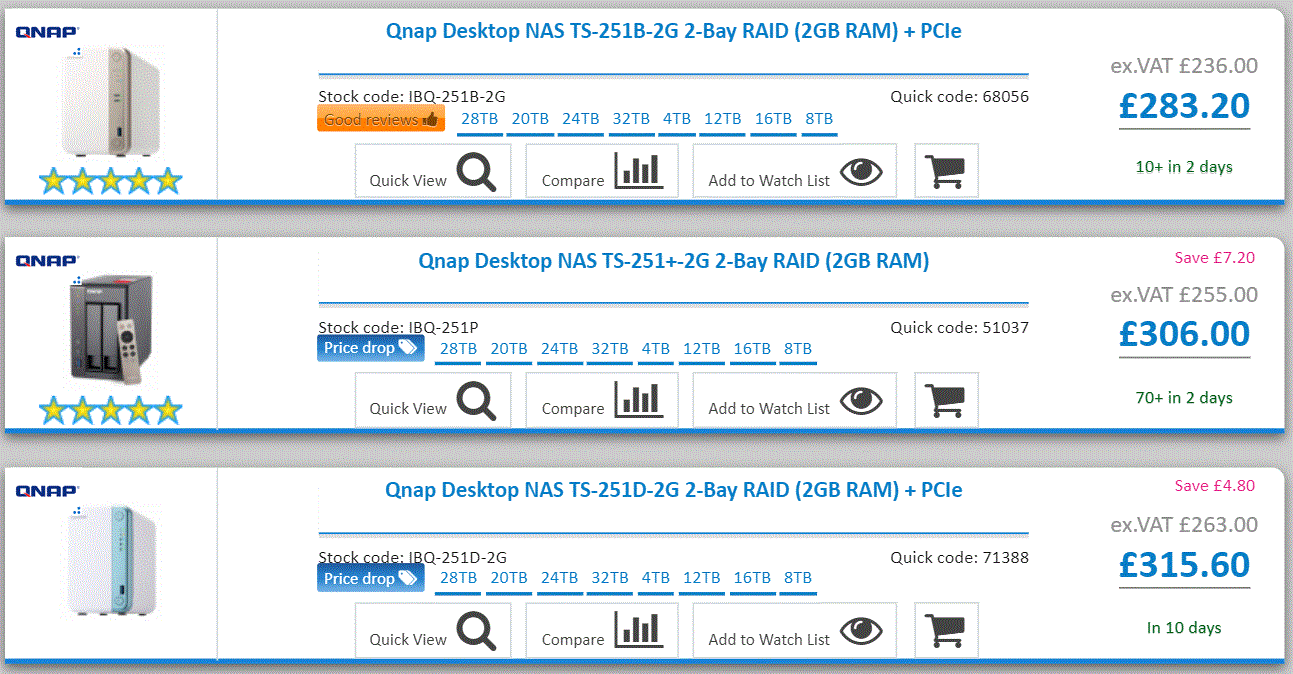
With the device being used for general but active file transfers, with 2x 4TB NAS Hard drives, QNAP stated power consumption of 8.08W in Standby and 15.25W whilst in use. The CPU is still pretty damn efficient for an affordable solution and this combined with the combination plastic chassis and internal metal frame results in a very surprising 16.7 db(A) sound level when in use – however, do remember that the hard drives you use will make all the difference when it comes to any noise, as newer hard drives at larger capacities create more noise (from more and denser platters and active cache inside).
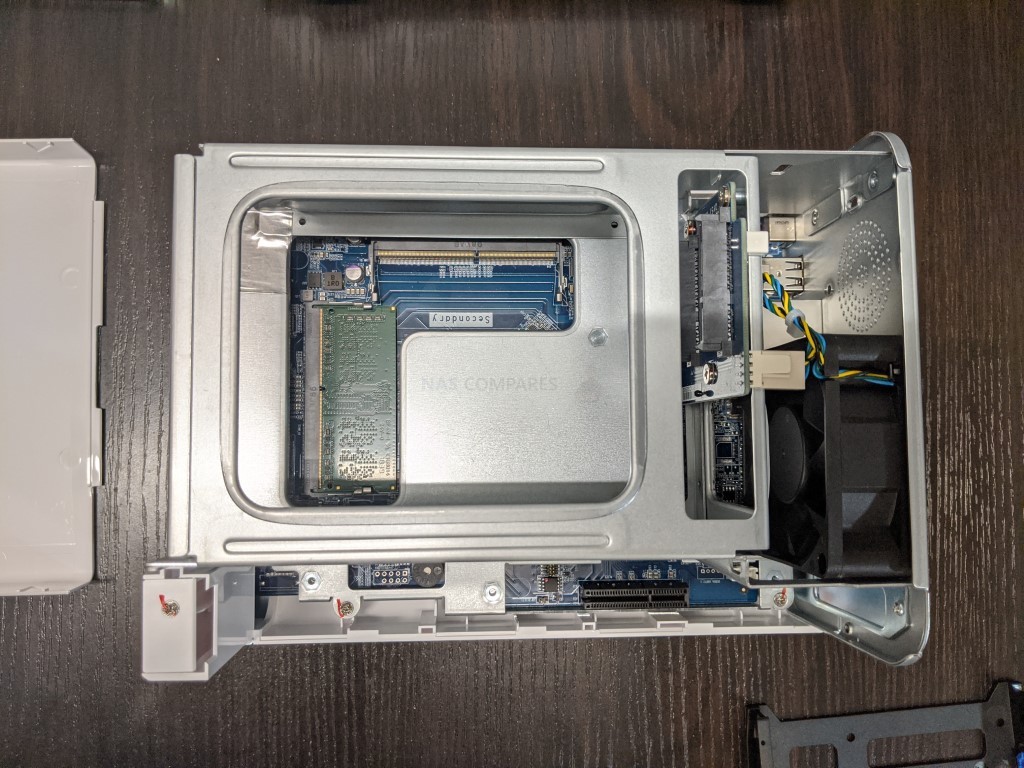
QNAP TS-251D NAS Review – Software
The QNAP TS-251D is more than just hardware and arrives with the QTS 4.4.1 NAS software. This software is included in the price of the TS-251D and is easily one of the best user interfaces and operating systems that are available for those users in both home and business circles. it is important to understand that when you buy the TS-251D server (or indeed any QNAP NAS), it arrives with the QTS software platform, with constant updates and hundreds of applications included. These are all tested and maintained 1st party QNAP apps and 3rd party applications. This is further improved with desktop client programs for PC/Mac and mobile applications for iOS and Android – ALL INCLUDED and downloadable at any time. The TS-251D can perform most modern applications that you would want from a modern NAS, such as:
QNAP QTS 4.4.1 File Highlights
- File Station
- QSirch
- QFiling
- SSD Caching
- QTier
- Microsoft Active Directory Support
- Access-Anywhere with myQNAPcloud
- Qsync for multiple hardware environment backups and Sync
Key Applications on the QNAP TS-251D
- Hybrid Backup Sync 3 – Allows you to Backup and Sync with Amazon Glacier, Amazon S3, Azure Storage, Google Cloud Storage, HKT Object Storage, OpenStack Swift, WebDAV, Alibaba Cloud, Amazon Drive, Amazon S3, BackBlaze B2, Box, Dropbox, OneDrive, Google Drive, HiDrive, hubiC, OneDrive, OneDrive For Business, ShareFile and Yandex Disk. As well as backup to another NAS over real time remote replication (RTRR) and USB connected media. All scheduled and all accessible via a single app user interface.
- QuMagie – Facial and Thing recognition application to help you retrieve, tag and catalogue photos by its use of AI to actually ‘view’ all your years of photos and let you search by the contents of them, not the file names.
- HD Station – The complete HDMI user interface, with it’s own applications and access. It can also be accessed via your web browsers and configured via the NAS
- vJBOD and Hybrid Mount – Gives you the ability to mount cloud storage as a visible drive within the NAS (and the apps access it as if it was local) or mount a % of space from your NAS onto another as a virtual chunk of space to use
- Multimedia Console – one portal access point to manage media access, searching, indexing and transcoding on your NAS device.
- Photo, Video and Music Station – Multiple file type tailored applications to access data in the best possible way that is suited to their output – along with smart searching, playlists and sharing
- Virtualization Station – Used to create virtual computers that can be accessed anywhere over the network/internet with the correct credentials. Supporting Windows, Linux, Android and more. You can import an existing VM image to the NAS, or you can even download Linux and Windows VMs directly to the NAS for trials for free
- Container Station – much like the VM app, Container station lets you mount and access smaller virtual tools and GUIs, then access them over the network or internet.
- Linux Station – Handy application to deploy multiple Linux based Ubuntu VMs from the NAS, all easily and within a few clicks
- QVR Pro and Surveillance Station – Surveillance applications that allow you to connect multiple IP cameras and IP speaks to your network and manage them with the applications. Arriving with 4 camera licenses for Surveillance Station and 8 for QVR Pro (the better one IMO), QNAP is constantly updating this enterprise-level surveillance application – adding newer security hardware and software tools for 2020 (see QVR Face and QVR Door)
- Download Station – A download management tool that can handle HTTP, BT, FTP and NZB files in bulk to be downloaded to your NAS drive and keep safe. As well as keeping an eye on your RSS feeds and keeping your podcast downloads automatically updated with every episode
- Malware Removers and Security Councillor – Along with Anti Virus software trials on the app centre, QNAP also provide numerous anti-intrusion tools and even a whole app interface to monitor in/outgoing transmissions with your NAS. It can make recommendations to beef up your security and keep you safe.
Mobile Applications for iOS and Android
- Qfile – File manager
- QPhoto – Photo Manager
- QVideo – Video Manager
- QMusic – Music Manager
- QVR Pro Mobile – Surveillance App
- QRemote – Remote Control App over the Network
- QNotes – Central note-taking app, for collaboration between users
- Full list here – https://www.qnap.com/en-uk/mobile-apps/TS-251D?category=productivity
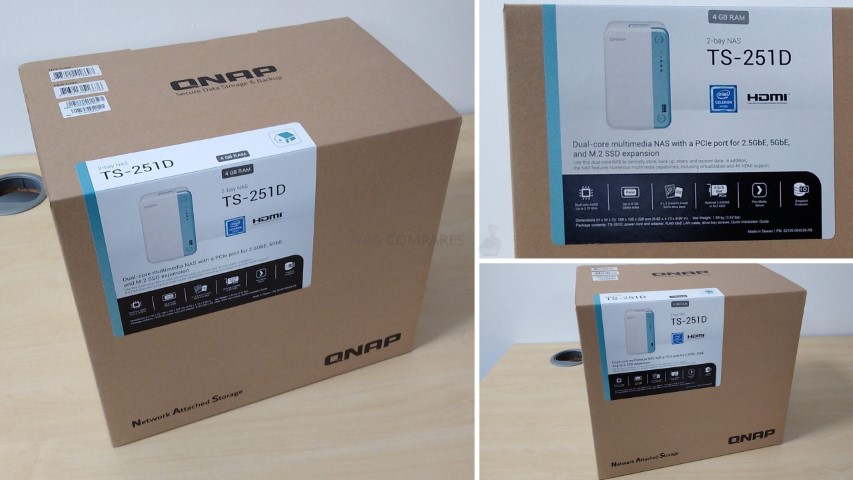
QNAP TS-251D NAS – Review Conclusion
The QNAP TS-251D makes a great start to 2020 (and indeed the decade) for the company with the launch of a new range of devices. The brand has long since shaken off the reputation of being a hardware provider and light software provider, becoming something much, much even. With a huge number of first-party applications in the QNAP QTS library (many of which are genuinely unique) as well as releasing an affordable 2-Bay NAS solution that has aimed itself at the new NAS buyer, or the NAS user who wants to spend a little now but can expand greatly later.
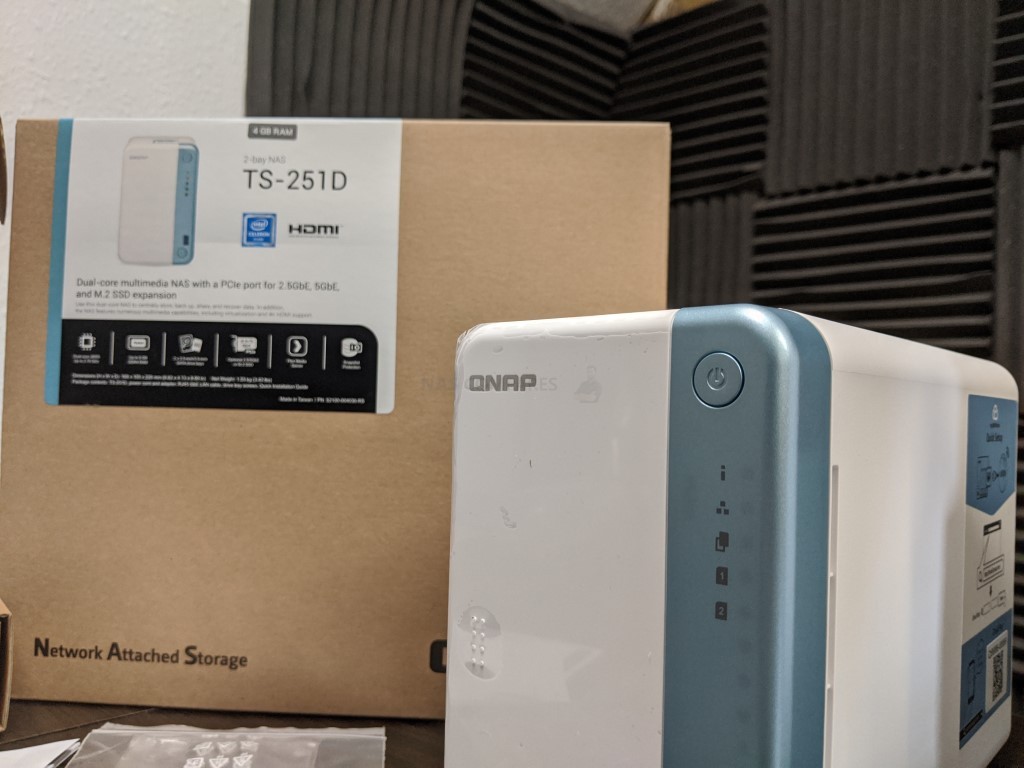
It isn’t perfect – a dual-core, not a quad-core. 1Gbe and not 2.5Gbe – but that is not the point in the TS-251D. This is aimed at the 2-Bay NAS buyer that want a good level of software and hardware performance, without breaking the bank. I will be doing further testing of this device over 10Gbe and how it performs with key applications in the QNAP app library, but overall the TS-251D is a great little NAS with a huge amount of potential for those that want their abilities to grow with their data.
| Pros of the QNAP TS-251D | Cons of the QNAP TS-251D |
|
|
A Quick Request to You – Yes, you reading this!
If you plan on buying your NAS Drive from Amazon, please use the links below for the best prices and Availability

📧 SUBSCRIBE TO OUR NEWSLETTER 🔔
🔒 Join Inner Circle
Get an alert every time something gets added to this specific article!
This description contains links to Amazon. These links will take you to some of the products mentioned in today's content. As an Amazon Associate, I earn from qualifying purchases. Visit the NASCompares Deal Finder to find the best place to buy this device in your region, based on Service, Support and Reputation - Just Search for your NAS Drive in the Box Below
Need Advice on Data Storage from an Expert?
Finally, for free advice about your setup, just leave a message in the comments below here at NASCompares.com and we will get back to you. Need Help?
Where possible (and where appropriate) please provide as much information about your requirements, as then I can arrange the best answer and solution to your needs. Do not worry about your e-mail address being required, it will NOT be used in a mailing list and will NOT be used in any way other than to respond to your enquiry.
Need Help?
Where possible (and where appropriate) please provide as much information about your requirements, as then I can arrange the best answer and solution to your needs. Do not worry about your e-mail address being required, it will NOT be used in a mailing list and will NOT be used in any way other than to respond to your enquiry.

|
 |
A Buyer's Guide to Travel Routers - GET IT RIGHT, FIRST TIME
Jonsbo N6 DIY NAS Case Review
The Best Bits (and Worst Bits) of NAS of 2025!
Minisforum MS-02 Ultra Review
Minisforum N5 NAS, 6 Months Later - Better, Worse, the Same?
Beelink ME Pro NAS Revealed
Access content via Patreon or KO-FI





Discover more from NAS Compares
Subscribe to get the latest posts sent to your email.


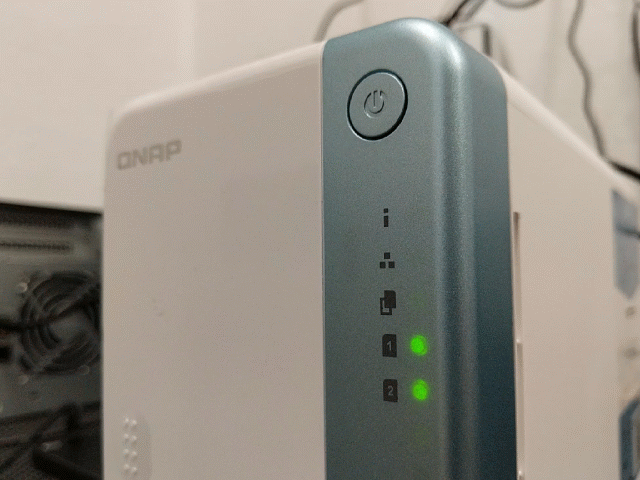



Anyone else unable to download plex to the hybridDesk station app? I have it downloaded on the main page but it’s not showing on hybridDesk station can anyone help please?
REPLY ON YOUTUBE
Can I install plex on this model?
REPLY ON YOUTUBE
Good lord how can you have thought it’s a good idea to upload a video of how this feature works when you hadn’t got it working yet?
What kind of demonstration is that??
REPLY ON YOUTUBE
My god… you seemed to have made it SO complicated.
I have a Turbo NAS account set up… but all I have on the TV screen (after plugging in the HDMI cable between the TS453B and LG TV) is “Please select a Turbo NAS account to log in”. How the heck do I “select” the Turbo NAS account? There’s my name there (in a box), but how on earth do I click on it? The arrow is there – as though it’s ready and waiting – but I can’t access it. And I certainly can’t move the arrow.
REPLY ON YOUTUBE
can this unit support 2x 16tb HDD
Raid 1 ?
REPLY ON YOUTUBE
I use one of these as a dedicated NVR, and another as a backup system as part of a 321 strategy.
Both have been in service for over a year, and rock solid.
REPLY ON YOUTUBE
I just ordered this one to replace my (awfull) WD Mycloud Duo, can anyone tell me if it is possible to just swap the harddisks and the Qnap reads them no problem? Or do I have to (painfully slow, as in days) get all the data off to an other storage, format the disks, install and tranfer data back?
REPLY ON YOUTUBE
its all nice as an idea, but in reality it seems to me (and i own qnap nas), that simple youtube and netflix app installed on my smart tv works better then same app on nas.
on the nas everything is very slow, even menu navigation is sooo laggy that its almost impossible to use.
i have TS-451-d2 QNAP with 12GB RAM and Celeron CPU.
its a shame that small ARM based xiaomi CPU installed in TV runs like king where 1000$ NAS is just glitchy as hell..
i think main reason is that weak intel CPU with bunch of qnap ‘bloatware’ OS is just not fast enough for such “multitasking”…
REPLY ON YOUTUBE
Working in the IT field for many years, I have watched as HDD reliability trends back and forth between WD and Seagate drives. Over the past 5-10 years, supporting thousands of desktops (mostly HP and Dell) which shipped with Seagate drives, I have observed a VERY HIGH HDD failure rate, even during the PC’s three year warranty period. Given this observation, (maybe their NAS drives are better than the drives they supply to OEM manufacturers), I wouldn’t trust a Seagate drive with any of my data. I’ll stick with WD drives for the time being, at least until Seagate gets their act together and I start seeing their failure rates come down.
REPLY ON YOUTUBE
too muxh talks and no hdmi video usage in that video…
REPLY ON YOUTUBE
Finally bought this one! It was an expense effort but excited about it, will receive it tomorrow probably. Bought 2xIronWolf 3tb and away we go. Took me such a long time to decide between the cheaper/steady options (Synology DS218) and the QNAP awesome Hardware. I wanted something with more oomph, and the DS218 was out of stock.. The 253D looks awesome but I drew the line ($) here.
REPLY ON YOUTUBE
Hello! Can i install only one hard disk instead of two?
REPLY ON YOUTUBE
Shame it cost a $100 more in 2022
REPLY ON YOUTUBE
Nice, I know it’s an old video, but I use iOS and on my devise, browsing folder under QSync share folder (trying to replace Dropbox) take between 12-25 sec to show the content, local network or LTE/5G, same results. Folder only contains 10-15 PDF files. Tap on one, spinning loading wheel, 5-8 sec, download time 1-2 sec (normal for a 2meg PDF)… it’s the spinning waiting that’s killing me!! Why ??
REPLY ON YOUTUBE
Is it too much to ask to get a tvs qnap HERO enabled with 5 or 6 -5.25 drives and 2 -2.5 drives and minimum 2.5g ethernet ? I cannot find anything similar. Either they do not offer Hero or tvs hdmi2.0
REPLY ON YOUTUBE
Hi NASCompares
Did you run any performance test over QNAP appliances? Is the built in tool reliable? I’ve got my TS-251D and i’ve upgraded up to 8GB with Kingston memories (2x KVR26S19S6/4). I’ve mounted 2 WD RED 4TB disks on RAID1 (2x WD40EFAX-68JH4N1). I ran several performance test and I always get similar results. Disk #1 always provides a SeqRead of ~400MB/Sec and 457iops while Disk #2 provides a SecRead of ~162MB/sec and 136iops.
I am a rookie on NAS so I lack of a lot of knowledge but according the disk specs I’d bet what’s wrong is the Disk #1 results which seem to be even better than the optimal disk performance specs.
I cannot explain the reason why I am getting that difference. Both disks are new (less than a month). I also ran a health test and both disks seems to be OK (no errors/bad sectors found). Is there any good reason to explain that huge difference?
I’d like also to mention that the performance difference could be “real” (?). While running large operation over those two disks, the Disk #1 always finishes first (2-3 times faster) than Disk #2. E.g.: while running a complete test looking for errors/bad sectors.
On a different subject I am also investigating if QM2-2P-244A expansion card could be useful on my NAS to improve read/write performance. NAS usage is for personal usage, backup and cloud storage consumed by mobile phone, laptop and so on while I am out of my home. I wanted to improve it by using a QM2-2P-244A and 2x 2TB Kingston KC2500 sticks. Not sure how much could it improve and I do not know if built in Celeron J4025 CPU will be able to take advantage of that expansion card + NVMe modules.
I am not thinking on Network expansions because I will not improve my home network or ISP provider so more network bandwidth on NAS side will be not a visible advantage on the usage.
Thank you in advance,
REPLY ON YOUTUBE
Great article! Covered everything I needed in extensive detail!
hello, is this ram compatible with the ts-251D? i want to upgrade my 4GB system to 8gb.
https://amzn.to/3np1sum
Yes, it should work.